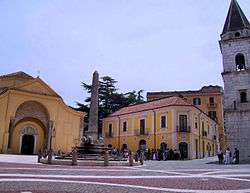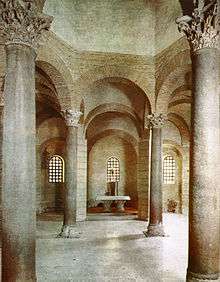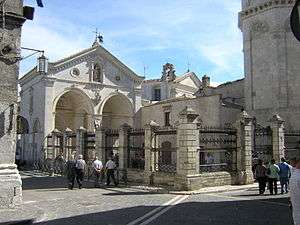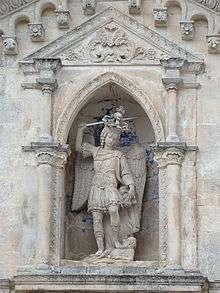Longobards in Italy, Places of Power (568–774 A.D.)
| Longobards in Italy. Places of Power (568–774 A.D.) | |
|---|---|
| Name as inscribed on the World Heritage List | |
|
| |
| Type | Cultural |
| Criteria | ii, iii, vi |
| Reference | 1318 |
| UNESCO region | Europe and North America |
| Inscription history | |
| Inscription | 2011 (35th Session) |
Longobards in Italy, Places of Power (568–774 A.D.) is the official name given by UNESCO to seven groups of historic buildings that reflect the achievements of the Germanic tribe of the Lombards (also referred to as Longobards), who settled in Italy during the sixth century and established a Lombard Kingdom which ended in 774 A.D.
The groups comprise monasteries, church buildings, and fortresses and became UNESCO World Heritage Sites in June 2011 as they testify "to the Lombards' major role in the spiritual and cultural development of Medieval European Christianity".[1]
List of sites
Cividale del Friuli (Province of Udine)
The Gastaldaga area and the Episcopal complex[2]
 The façade of the Cathedral.
The façade of the Cathedral.- Church of Santa Maria in Valle in the Gastaldaga area.
- The Tempietto Longobardo.
- The palladian Palazzo Pretorio in the Episcopal complex.
Brescia
The monumental area with the monastic complex of San Salvatore-Santa Giulia[3]
- The Capitolium in the monumental area of the Roman forum.
- Basilica of San Salvatore.
_int2.jpg) Church of Santa Maria in Solario.
Church of Santa Maria in Solario.1.jpg) The nun's choir of the monastery of San Salvatore-Santa Giulia.
The nun's choir of the monastery of San Salvatore-Santa Giulia.
Castelseprio (Province of Varese)
The castrum with the Torba Tower (later part of Torba Monastery) and the church outside the walls, "Santa Maria foris portas"[4]
- The Torba Tower.
- Remains of the basilica of San Giovanni Evangelista.
- Church of Santa Maria foris portas.
 Santa Maria foris portas, detail of the frescoes.
Santa Maria foris portas, detail of the frescoes.
Spoleto (Province of Perugia)
The basilica of San Salvatore[5]
 The façade of the basilica of San Salvatore.
The façade of the basilica of San Salvatore. Detail of the portal.
Detail of the portal. Internal view of the basilica.
Internal view of the basilica. The presbitery.
The presbitery.
Campello sul Clitunno (Province of Perugia)
 The façade of the Clitunno Tempietto.
The façade of the Clitunno Tempietto. Lateral view of the Tempietto.
Lateral view of the Tempietto. External view of the apse.
External view of the apse. Internal view of the apse.
Internal view of the apse.
Benevento
 The Santa Sofia complex.
The Santa Sofia complex. The portal of the church.
The portal of the church. Internal view of the church.
Internal view of the church._affresco_fine_VIII_inizio_IX_secolo.jpg) Detail of the frescoes, with the Annunciation of Zacharias.
Detail of the frescoes, with the Annunciation of Zacharias.
Monte Sant'Angelo (Province of Foggia)
The Sanctuary of San Michele[8]
 The Sanctuary of San Michele
The Sanctuary of San Michele Statue of Saint Michael overlooking the entrance of the sanctuary.
Statue of Saint Michael overlooking the entrance of the sanctuary. The octagonal tower (campanile) of the sanctuary
The octagonal tower (campanile) of the sanctuary The cave where the Archangel Michael is said to have appeared
The cave where the Archangel Michael is said to have appeared
See also
References
- ↑ Longobards in Italy - UNESCO World Heritage Centre
- ↑ ""Cividale del Friuli: description of heritage" on Italialangobardorum.it". Retrieved 2 May 2014.
- ↑ ""Brescia: description of heritage" on Italialangobardorum.it". Retrieved 2 May 2014.
- ↑ ""Castelseprio: description of heritage" on Italialangobardorum.it". Retrieved 2 May 2014.
- ↑ ""Spoleto: description of heritage" on Italialangobardorum.it". Retrieved 2 May 2014.
- ↑ ""Campello sul Clitunno: description of heritage" on Italialangobardorum.it". Retrieved 2 May 2014.
- ↑ ""Benevento: description of heritage" on Italialangobardorum.it". Retrieved 2 May 2014.
- ↑ ""Monte Sant'Angelo: description of heritage" on Italialangobardorum.it". Retrieved 2 May 2014.
